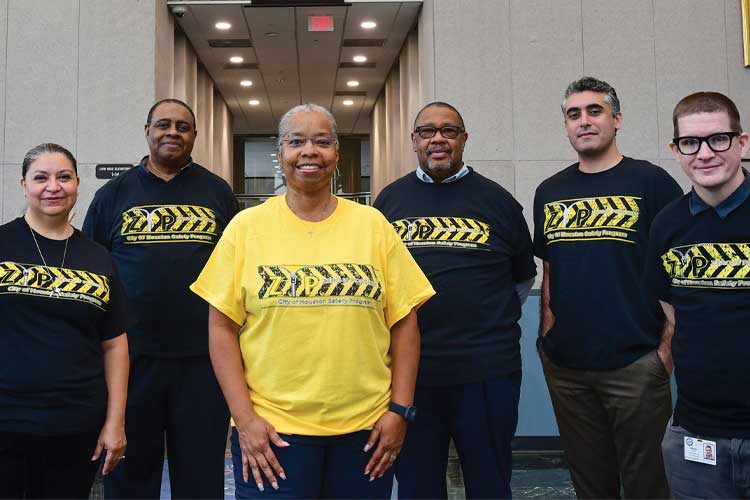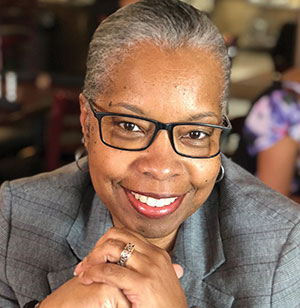The 2023 CEOs Who “Get It”

Jane E. Cheeks
Director of Human Resources
City of Houston
Houston, TX

The City of Houston provides the services and programs necessary to take care of the nation’s fourth largest city and its residents. With a workforce of over 21,000 in 26 departments, the city’s responsibilities include maintaining infrastructure, providing public health services, maintaining parks and providing recreational facilities and activities, managing three airports, supporting neighborhoods and their residents, promoting public safety, enhancing sustainability, supporting businesses and entrepreneurship, and a host of other activities.
Describe your personal journey to becoming a CEO who “gets it.” What experiences or lessons brought you to where you are now?

When Mayor Sylvester Turner confirmed me as the human resources director, safety was at the forefront of what I wanted to accomplish. We had a phenomenal team, which I believe had been stifled in its creativity. I wanted to unleash their capabilities in a manner that the city had never seen, and I wanted us to stop being so reactive to things and start being proactive to address what was necessary. I also think it’s important that we realize that it’s usually our employees who can actually help us accomplish our safety strategies and goals. When you allow their ideas to come to fruition, you see great and wonderful things. That’s what happened with me. The team had great and wonderful ideas, and it was my responsibility to remove any obstacles and give them the opportunity to be successful in what they wanted to do.
It also helped that the mayor saw safety as a priority, but on a bigger scale that covered the whole city. As he worked on his Safe Houston initiative, we were working on our Zero is Possible (ZIP) program, a standards-based safety campaign with the primary goal of driving the city’s occupational safety awareness and mindset toward zero accidents, zero injuries and zero safety compromises. The mayor’s program was implemented first, which allowed us to pivot and gain more attention for our internal policy that was approved hours later.
Believe it or not, employees pay attention. Hearing things from the top is a good thing, but when they see you implement things from the bottom that rise to the top, it’s even better. When we started rolling out the ZIP initiative, it had to be a collaboration between human resources, the departments and the employees! Using that formula as a guide, we were able to get directors from all departments to understand our vision with ZIP, and see how the initiative had to be embraced at the highest level, so that the employees could actualize it at their level.
We incorporated our Talent Management System into the administrative process so that employees could take safety courses online and, upon completion, get a ZIP Safety T-shirt. Believe it or not, this was one of our biggest successes in implementing the program. We found employees taking the safety training even before it was rolled out in their department, so that they could receive one of the T-shirts. You might find that odd, but we said, “Whatever works!”
We also needed to recognize opportunities to enhance our risk management programs. As a result, we created a specialized safety team focused on high-risk public works operations; a specialized chemical, biological, radiological, nuclear and explosive safety task force; and a citywide campaign to launch the ANSI Z10 system.
What is the biggest obstacle to safety at your organization? How do you work to overcome it?
The City of Houston has over 21,000 employees and operates 26 municipal departments that serve more than 2.3 million Houstonians across 669 square miles. Additionally, the city has over 10,000 contractors. Our biggest obstacle is to engage and educate all of our employees in their respective fields.
To overcome these challenges, we use our Talent Management System to administer a foundational set of safety trainings with six mandatory courses covering high-frequency hazards. Additional courses are periodically developed and advertised throughout the year. All City of Houston drivers receive defensive driving training every three years, along with a full Safe Driving program; and all CPR/first aid/AED providers receive recertification training every two years.
Citywide and departmental new employee orientation programs were updated to include safety-related information. Over 50,000 safety promotional materials have been distributed. A citywide safety newsletter was created with monthly distribution, while over 100 safety bulletins are created each year, along with posters, quick reference cards, checklists and much more. Public health safety advisors led the citywide COVID-19 and mpox (formerly known as monkeypox) responses, including providing safety advice to hundreds of external partners and participating in a variety of events.
Why is safety a core value at your organization?
Our primary goal is to have employees return home from work in the same condition in which they came. We accomplish this by growing a culture of safety awareness and accountability, and collaborating interdepartmentally to reduce injuries, costs and loss of work productivity. We believe that safety doesn’t happen by accident. Implementing safety measures and accident prevention practices can enhance efficiency rather than supersede or interfere with work productivity.
How do you instill a sense of safety in employees on an ongoing basis?
The ZIP program is our safety campaign that has the primary goal of driving the city’s occupational safety awareness and mindset toward zero accidents, zero injuries and zero safety compromises.
We emphasize that each employee plays a vital role in fostering a safe work environment by:
- Becoming a safety ambassador – “If you see something, say something”
- Being aware and alert to potential hazards at all times
- Reporting incidents, hazards, safety violations, near misses, and unsafe acts and conditions
- Setting an example for co-workers by knowing, reinforcing and following safety rules
We also instituted ZIP Fridays, when we wear our ZIP T-shirts to show our support for a safer City of Houston. The HR Risk Management team meets in the lobby of our building and provides safety tips and holds safety policy and procedure trivia contests to win prizes. This is another example of how we actively engage employees. We also send out a monthly ZIP newsletter and conduct monthly safety meetings consisting of representatives from all city departments.
How does your organization measure safety? What are the leading indicators that show you how safe your organization is, and where do you see room for improvement?
Our safe work practices were validated through over 1,000 work observations and over 500 facility inspections each month showing a reliable 98% safe work practices and 99% safe work conditions. Over 200 near-miss reports are analyzed each month. Departments have their own safety recognition programs, while a citywide safety committee has its own monthly Safety Champion recognition.
Within the citywide rates, individual department rates show the benefits of the immersive safety management system. For example, the City of Houston Health Department’s compensable claims rate is 1.33 per 100 employees, and its days away, restrictions and transitional duty rate is only 0.89 per 100 employees. Compared with the health care industry’s Bureau of Labor Statistics’ OSHA-recordable rate of 5.5 per 100 employees, the City of Houston’s public health compensable claims rate is significantly lower than the industry’s national standard.
All incidents are comprehensively analyzed to determine preventive measures for continual improvement. Furthermore, an electronic online safety management system has been implemented to better consolidate, analyze and track all data. This system has transformed the City of Houston’s culture proactively, with reliable controls and culture-enabling improvements. This has led to significant increases in safe work, even during high-risk times such as the COVID-19 pandemic, when the city’s safety management team led reliable respiratory protection measures, contamination control and other controls validated by consistent leading indicators.
This level of hazard control has been recognized by the Public Health Service Commissioned Corps, the Federal Emergency Management Agency, the National Safety Council, the Association for Occupational Health Professionals in Healthcare, and the American Society of Safety Professionals, among others.
I empower my teams by encouraging them to participate in career development activities, even beyond the borders of the United States. As a result, the resources and programs produced by my teams are routinely requested by a variety of other municipalities and employers.
What role does off-the-job safety play in your organization’s overall safety program? What types of off-the-job safety and health programs does your organization offer to employees?
Off-the-job safety is just as important as on-the-job safety, if not more important. Statistically, more incidents happen away from work than at the workplace. That’s why we frame our safety programs, such as ZIP and our wellness programs, to extend beyond the workplace and into our employees’ lives at home. Safety doesn’t stop when you leave the office or worksite, it’s a constant state of mind. To keep that state of mind and ensure safe behaviors become habits, we incorporate work and home safety holistically. We include work hazards and home hazards in most of our safety committee meetings, across all departments. Many topics are explained as applicable to both environments (ladders, slips/trips/falls, electrical, fire, strains, etc.) and areas such as holiday safety are covered consistently. We encourage all our employees to apply all our safety strategies in their personal lives, and market our safety programs to be used as such. Safety isn’t exclusive to work, and our employees know that.
What have you done to support employee mental health and well-being within your organization?
We administer the employee assistance program through the HR benefits division. This service is a benefit provided to employees and their family members. It is free and confidential and can assist employees with resolving personal and work problems, which may be impacting performance. The EAP is a leader in following the Drug-Free Workplace Act, and serves as an important resource for supervisors and managers by providing consultation and education. A supervisor has the option to informally refer an employee to the EAP, where licensed counselors can provide assessment and appropriate referrals or provide counseling to help resolve personal and/or work problems. The EAP is also available to assist with grief counseling, as well as deploy to various departments/locations to support employees in response to catastrophic or other emotionally impactful events.
The city has one of the few in-house EAPs, while most entities outsource this service. We believe that this instills a higher level of trust and shows our employees that we genuinely care about their well-being. We also contract with a firm to provide 24-hour assistance for a variety of issues, as well as support the in-house team when needed.
We recently introduced Municipal Bereavement Liaison Services, which provides assistance when a city employee or a member of the employee’s immediate family dies. The bereavement liaison is the single point of contact to help employees and their families navigate various benefits and services available.
Post a comment to this article
Safety+Health welcomes comments that promote respectful dialogue. Please stay on topic. Comments that contain personal attacks, profanity or abusive language – or those aggressively promoting products or services – will be removed. We reserve the right to determine which comments violate our comment policy. (Anonymous comments are welcome; merely skip the “name” field in the comment box. An email address is required but will not be included with your comment.)


